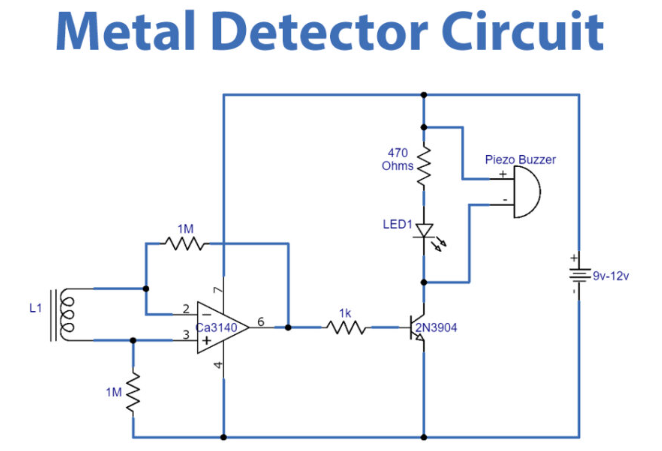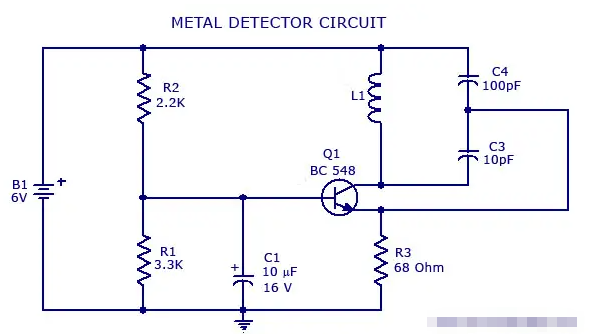金属探测器,Metal detectors
关键字:金属探测器,探测器电路,金属探测器电路

The circuit described here is that of a metal detector. The opera- tion of the circuit is based on superheterodyning principle which is commonly used in superhet receivers. The circuit utilises two RF oscillators. The frequencies of both oscillators are fixed at 5.5 MHz. The first RF oscillator comprises transistor T1 (BF 494) and a 5.5MHz ceramic filter commonly used in TV sound-IF section. The second oscillator is a Colpitt’s oscillator realised with the help of transistor T3 (BF494) and inductor L1 (whose construction details follow) shunted by trimmer capacitor VC1. These two oscillators’ frequencies (say Fx and Fy) are mixed in the mixer transistor T2 (another BF 494) and the difference or the beat frequency (Fx-Fy) output from collector of transistor T2 is connected to detector stage comprising diodes D1 and D2 (both OA 79). The output is a pulsating DC which is passed through a low-pass filter realised with the help of a 10k resistor R12 and two 15nF capacitors C6 and C10. It is then passed to AF amplifier IC1 (2822M) via volume
control VR1 and the output is fed to an 8-ohm/1W speaker. The inductor L1 can be constructed using 15 turns of 25SWG wire on a 10cm (4-inch) diameter air-core former and then cementing it with insulating varnish. For proper operation of the circuit it is critical that frequencies of both the oscillators are the same so as to obtain zero beat in the absence of any metal in the near vicinity of the circuit. The alignment of oscillator 2 (to match oscillator 1 frequency) can be done with the help of trimmer capacitor VC1. When the two frequencies are equal, the beat frequency is zero, i.e. beat frquency=Fx-Fy=0, and thus there is no sound from the loudspeaker. When search coil L1 passes over metal, the metal changes its inductance, thereby changing the second oscillator’s frequency. So now Fx-Fy is not zero and the loudspeaker sounds. Thus one is able to detect presence of metal
control VR1 and the output is fed to an 8-ohm/1W speaker. The inductor L1 can be constructed using 15 turns of 25SWG wire on a 10cm (4-inch) diameter air-core former and then cementing it with insulating varnish. For proper operation of the circuit it is critical that frequencies of both the oscillators are the same so as to obtain zero beat in the absence of any metal in the near vicinity of the circuit. The alignment of oscillator 2 (to match oscillator 1 frequency) can be done with the help of trimmer capacitor VC1. When the two frequencies are equal, the beat frequency is zero, i.e. beat frquency=Fx-Fy=0, and thus there is no sound from the loudspeaker. When search coil L1 passes over metal, the metal changes its inductance, thereby changing the second oscillator’s frequency. So now Fx-Fy is not zero and the loudspeaker sounds. Thus one is able to detect presence of metal
声明:本文内容及配图由入驻作者撰写或者入驻合作网站授权转载。文章观点仅代表作者本人,不代表电子发烧友网立场。文章及其配图仅供工程师学习之用,如有内容侵权或者其他违规问题,请联系本站处理。
举报投诉
发布评论请先 登录
相关推荐
用于光波导系统的均匀性探测器
提供了均匀性探测器,可以进行所需的研究。在本文件中,我们将演示可用的选项以及如何操作均匀性探测器。
**案例演示 **
**均匀性探测器
**
**探测器功能:相干参数 **
如
发表于 12-20 10:30
雷达探测器的工作原理 雷达探测器与激光探测器区别
雷达探测器是一种利用雷达技术来检测和跟踪目标的设备。它的工作原理基于电磁波的发射和接收。以下是雷达探测器的基本工作原理: 发射电磁波 :雷达探测器会发射一定频率的电磁波,这些波以光速传播。 目标反射
VirtualLab:通用探测器
摘要
通用探测器是VirtualLab Fusion中来评估和输出电磁场任何信息的最通用工具。它能够提供不同域(空间域和空间频域)和坐标系(场与探测器位置坐标系)的信息。此外,通过使用非常灵活的内置
发表于 08-06 15:20
金属探测器工作原理是什么 金属探测器能探多少米
金属探测器是一种广泛应用于许多领域的电子设备,它能够探测和定位埋藏或隐藏在地下、水下等介质中的金属物体。金属




 金属探测器,Metal detectors
金属探测器,Metal detectors












评论